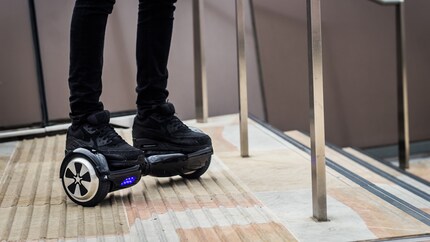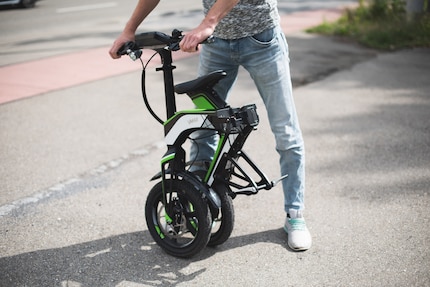

e-mobility: the lie of the land
What was pure science fiction just a few years ago is now a fixture on our roads. You see everything from smart wheels to hoverboards and e-scooters. Electric-powered vehicles are changing our day-to-day lives. Now almost anything seems possible – but what exactly are you allowed to use where?
The e-era is gaining increasing momentum and leading to a transport revolution. New products are forever being added to the market, making it fast-growing and hard to navigate. The developments are indeed practical. You could even say e-bikes have got people back into cycling, and e-scooters can help with that last mile of your trip through a city centre. They make it easy and quick for you to get from the station to the office under your own steam. But equally, the lines seem to be blurring between toys and modes of transport. And that comes with inherent risks. For one thing, not everyone knows where it’s legal or not to use these modes of transport. The issues often start right outside your front door.
Only on private property – what does that even mean?
A lot of e-transporters aren’t allowed in public places as they don’t have type approval (info in German) and don’t comply with the Swiss regulation on technical requirements for street vehicles, known as the VTS or Verordnung über die technischen Anforderungen an Strassenfahrzeuge in full) (info in German). That means streets, pavements, parks and pedestrianised areas are off limits. And this list isn’t even complete. When a traffic area is open to the public, it’s classed as public, meaning it’s illegal for you to use your hoverboard or e-skateboard there. You’re only allowed to use these e-vehicles in cordoned off, private areas.

You might see hoverboards and other e-vehicles fairly often in public places but you’re not actually allowed to use them there. Flickr/Ben Larcey (CC BY 2.0)
If you don’t have a private street, an enclosed inner court or an extremely roomy garage, your options for permitted places to use them are limited. You’ll see a lot of these vehicles in places where you’re not allowed to use them, namely in public spaces. If you do, it can result in criminal proceedings. And if you had an accident, you’d be paying more than just a fine. What's more, the insurance issues below can be complex and expensive.
Forbidden in public places (as of March 2020):
Hoverboards and e-unicycles could indeed theoretically fall into the «self-balancing vehicle» category. As of 1 July 2015, this is a sub-category of motor-assisted bikes (mopeds). You can find more information in German in this leaflet from the Swiss Federal Roads Office FEDRO. Unlike the traditional Segway and some e-scooters, they (still) don’t meet the requirements and there’s no model with type approval.
e-scooters up to a max of 20 km/h treated the same as bikes
If you’re looking for a mode of transport that’s both compact and allowed to be used on the road, your best bet is an e-scooter or e-transporter. Scooters with a maximum speed limit of 20 km/h and engine performance capped at 500 watts don’t need type approval or a number plate. As with e-bikes, they fall into the category of light motor-assisted bikes. An example from our range is the Inokim Light 2 Super.

See all transporters and scooters in our range
Which rules apply to these scooters?
- For 14- to 16-year-olds, a driving licence in the M category is required.
- The same applies to scooters as it does bikes – the law doesn't require you wear a helmet (but it’s recommended).
- You must use cycle paths.
- You must have a bell, breaks on the back and front, lights (not the flashing kind) and a backlight (red).
Why «only» 20 km/h?
e-bikes and mopeds can go at 25 km/h with the help of a motor. There’s a distinction between the highest speed the vehicle is built for and the highest speed that can be reached with the help of pedalling. The highest speed the vehicle is built for means that the vehicle is allowed to go faster than 20 km/h on the flat when it’s just being controlled by the motor. If you can also pedal to power the vehicle, the motor can only support speeds of up to 25 km/h.
If the designed maximum speed is more than 20 km/h or the motor is between 500 and 1000 watts, the vehicle falls into the motor-assisted bike category and requires a type approval. With the right driving licence, you get the yellow moped number plate and badge. In this category, it’s also compulsory to wear a helmet. One of the things your vehicle will need is a rear-view mirror, like the ones mounted on e-bikes that reach speeds up to 45 km/h (S-Pedelecs).

The road traffic leaflet called «Trendfahrzeuge» issued by Zurich city police and the breakdown assistance company TCS’s table with graphics give a good overview of the current legal situation. It’s all in German at the moment, I’m afraid. If new rules are passed about e-vehicles, I’ll update this article.
Simple writer and dad of two who likes to be on the move, wading through everyday family life. Juggling several balls, I'll occasionally drop one. It could be a ball, or a remark. Or both.
Practical solutions for everyday problems with technology, household hacks and much more.
Show all

